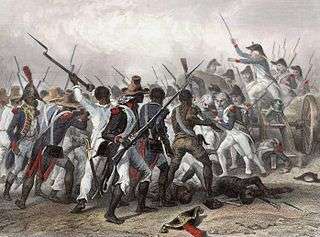Battle of Crête-à-Pierrot
| Battle of Crête-à-Pierrot | |||||||
|---|---|---|---|---|---|---|---|
| Part of the Haitian Revolution | |||||||
 Attack and take of the Crête-à-Pierrot by Auguste Raffet. | |||||||
| |||||||
| Belligerents | |||||||
| France | Haitian rebels | ||||||
| Commanders and leaders | |||||||
| Charles Leclerc | Jean-Jacques Dessalines | ||||||
The Battle of Crête-à-Pierrot was a major battle of the Haitian Revolution taking place from 4 March until 24 March 1802.
The battle took place at the Crête-à-Pierrot fort (in Haitian Creole Lakrèt-a-Pyewo), east of Saint-Marc on the valley of the Artibonite River. The French colonial army consisting of 2,000 men led by General Charles Leclerc blockade the fort, defended by Jean-Jacques Dessalines's Haitian rebels.[1] Preventing or allowing access to the Cahos Mountains, the fort was strategically important. With drained food and munitions supplies, Dessalines's rebels forced through the French blockade and escaped the French and went to the mountains. Here, Dessalines's forces massacred many French civilians, and regained control of the Crête-à-Pierrot fort on 11 March.[1]
On 12 March, the French forces attempted to gain control of the fort but failed; Jean Boudet's French forces suffered losses of 480, and Dessalines's forces suffered losses of 200-300. Another attempt was made on 22 March which led to 300 French deaths.[1] On 24 March, Dessalines's forces abandoned the fort in the night due to heavy losses, and the French gained control of it.[1] Despite gaining control of the fort, the French had suffered major losses, including the death of General Charles Dugua.[1] Alexandre Pétion, a mixed-race French general, played an important role in the capture of the fort when he managed to deploy his cannon on a hill overlooking the Haitian position.
Following the battle, Dessalines temporarily swore allegiance to France and joined his forces with Leclerc's, leading Toussaint Louverture, the Haitian leader, to agree to surrender. Though a defeat for the Haitians, the battle demonstrated their fighting qualities and showed that they could cause significant casualties to regular European forces.[1] When disease disabled much of the French army, Dessalines once again returned to the field, now as the leader of the Haitian forces after the arrest and death of Louverture, and the story of the stubborn resistance of the Haitians at La Crête à Pierrot helped give his troops confidence.[2]
References
External links
- The Battle of Crête-à-Pierrot. The Louverture Project.
Coordinates: 19°07′00″N 72°27′00″W / 19.1167°N 72.4500°W